M.B. Pedersen's Blog, page 3
November 9, 2015
Monster Mondays 8: Xenomorphs
In the haunted depths of space no one can hear you scream, and if you have these malignant creatures aboard you may not even get the chance to. They are...
The Xenomorphs
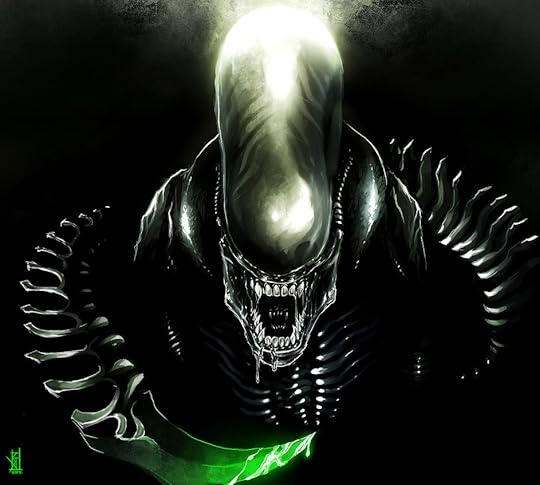
art by TheRisingSoul at Deviantart.com
The Xenomorph was originally seen in the 1979 science fiction/horror film Alien. They, along with most other alien related things in the film, were designed by famed artist H. R. Giger. The creatures themselves, in their most reoccurring and famous form, are black shelled (the shell is replaced with a slick looking, amphibious skin in newer interpretations) creatures with a roughly human shape, thin limbs ending in razor sharp claws, a long tail ending in a blade like growth, an eyeless head that curves back into a type of dorsal plate, and a mouth full of sharp teeth and a smaller, secondary mouth in place of a tongue. The Xenomorphs have appeared in film, comics, and a number of action figure lines, many of which present different origin stories and powers.

What is true across all interpretations is that they possess acidic blood and develop through several juvenile stages before reaching maturity. The life cycle, explained in greater detail else where on the web, begins with an egg. The egg releases a spidery, parasitic organism known as a facehugger which latches onto a host, implanting a new, smaller egg into them. The egg hatches and develops into a serpent like creature known as a chestburster, named after its penchant for bursting out of its host chest in a gore splattered spectacle.

It is at this stage of development that the xenomorph is at its most vulnerable. While the chestburster is remarkably quick and is capable of biting through flesh and bone it has little other defenses, save its acidic blood which would make it harmful to most predators at the very least. The chestburster typically flees and finds a secluded area where it can grow in peace. It then coats itself in a membranous cocoon like structure. It sheds this secondary skin an indeterminate number of times until it has finally reached maturity. A remarkable attribute possessed by the species is the uncanny ability to take traits from its host organism that become applied in its fully matured form (perhaps a residue of the remarkable adaptability shown by the black ooze in the film Prometheus). This allows it to not only adapt to its surroundings better, but also render it better suited to track down other hosts.

art by hideyoshi at deviantart.com
Mature xenomorphs act as vicious predators when found alone, indiscriminately killing any living thing they come across, and often destroying machinery or androids that may get in their way. This is somewhat atypical however, as the xenomorph is at its heart a hive creature, similar to social insects found on Earth. Special eggs, the process by which they are made differs from version to version, develop into praetorian when fully mature. These are essentially larger xenomorphs with a longer dorsal plate. When a praetorian detects that there is no queen in the vicinity it forms another cocoon and develops into one. The xenomorph queen is a far larger specimen than its drones, so much so that it might be considered a form of megafauna. The queen can be distinguished, other than by its size, by its incredibly large dorsal plate, a secondary pair of arms, and potentially a huge, grotesque birthing sac that continually produces new eggs. The queen controls the drones that protect her, either through pheromones or some form of little understood alien telepathy, and they protect her with their lives. She becomes the heart of a new colony structure, the drones hunting new hosts to bring back for either food or to be given over to a facehugger. A thick, black substance is typically used to secure prisoners as well as build up the colony, and it is typically accepted that the drones secrete it somehow.
November 3, 2015
Reliquary Tuesdays 7: The Elixir of Life
Created by only the most learned alchemists and sought after by the most feverishly deranged tyrants, this week's relic is a grouping of potions and solutions known as...
The Elixir of Life

The Elixir of Life is a potion reported to provide anyone who drinks it with varying degrees of eternal life. Kings and Noblemen throughout history have sought it, terrified of losing the earthly power they have gained. Comte De St. Germain, an 18th century nobleman, was said to have a version of the elixir. He was reported as living for several hundred years, though information on this is sketchy at best. The Qin Dynasty Emperor of China Qin Shi Huang was obsessed with obtaining the elixir, and requisitioned the Taoist alchemist Xu Fu to locate it for him. Xu Fu gathered a group of 500 young men and 500 young women and explored the Eastern seas for the famed elixir, legend holds that he did not locate it, but found Japan instead. In ancient Chinese alchemy it was believed that consuming precious gems, particularly long lasting varieties, would infer some level of their longevity. This included jade, cinnabar, hematite, and especially gold. In the famous Chinese alchemical book Danjing Yaojue (Essential Formulas of Alchemical Classics), written by Sun Simiao, there are a number of elixirs said to impart longevity concocted from mercury, sulfur, and arsenic. In reality most of these substances were highly toxic, giving any who drank them crippling illness or even death. It's doubtful any such concoction could be derived using ancient alchemical techniques, though if it were to exist it would likely be kept secret by those who discovered it...
Sorry for the lateness of this week's Reliquary post, lots going on over on my end, hopefully I'll have some more publishing news for you all
November 2, 2015
Monster Mondays 7: Eye-Biters
Terrorizing Irish farmers and their cattle, this week's practitioner of the dark arts specializes in blights and curses. They are...
The Eye-Biters

The Eye-Biter is a type of witch found in Irish folklore. Through what can be described as pagan magic they were capable of cursing cattle, rendering them blind. A type of blight spreading through 16th century Ireland rendered hundreds of livestock blind, causing a surge of hysteria which ended with over a dozen people being accused of being eye-biters.
information provided by The New Encyclopedia of the Occult
October 27, 2015
Reliquary Tuesdays 6: The Pnakotic Manuscripts
Locked within a bizarre repository of knowledge created from the study of all time and space, this week's relic is a tome of untold esoteric power. It is the gift of the Great Race of Yith, and it is known as...
The Pnakotic Manuscripts

The Pnakotic Manuscripts are a collection of alien histories and cultural treatise originally created in scroll form by the Great Race of Yith. They first appeared in the work of H.P. Lovecraft, first mentioned in his story "Polaris". It has since become a reoccurring member in the Cthulhu Mythos' library of blasphemous tomes. The first five chapters were made by the Great Race of Yith, a race of time traveling aliens obsessed with collecting knowledge in all its forms, and the information in those chapters detail the history of their species. This history includes their war with the Flying Polyps, their planet's eventual destruction, and their eventual mass migration into the bodies of a race of beetle people who will inherit the Earth after Mankind's destruction. Later chapters were added by a various inhuman species, such as the vormiis in Hyperborea, as the manuscripts were passed down and translated into new languages. An original, unaltered copy is said to reside in the Yith's library city of Pnakotus, which is where its name originates. A Greek translation was made known as Pnakotica. An English edition was also eventually written, created by an unknown scribe.
October 26, 2015
Monster Mondays 6: Beezlebub
A god of the Canaanites and a prince of Hell, this week's monster has stalked the world and tainted countless souls. Lord of Demons in Hebrew belief, he is known as...
Beezlebub

Beelzebub is one of the older demons within the Hebrew and Christian belief systems. His name has come to mean "The Lord of Flies", but within the original Canaanite language his name was Baal-Zebul, the prime diety and "Lord of the Divine Abode". In appearance he has two major depictions. The first, and most popular thanks to his title, is that of a giant, grotesque fly. The second is of a great, hideous being sitting upon a mighty throne. Oddly enough, this second depiction often includes such details as large nostrils, duck feet, bat wings, horns, a lion's tail, a swollen face and chest, and an abundance of coarse, black fur.
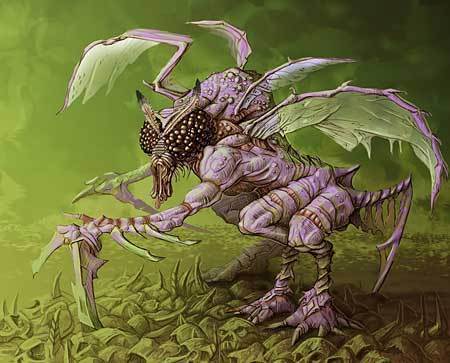
Beezlebub appears prominently in many Christian texts, most notably the bible. In the gospel of Matthew the Pharisees, a political and social group in the Holy Land, accused Jesus of making dark pacts with Beezlebub. The reason for this is because Jesus was performing exorcisms, and it was believed that the ability to cast out dark spirits came from making infernal pacts. It is also believed that Beezlebub seized control of Hell and all its legions from Satan in an altercation involving Jesus. After the crucifixion of Christ Satan told Beezlebub that he was going to drag him down to Hell to punish him for all his transgressions against demonkind. Beezlebub was terrified and begged him not to, thinking that Jesus was too strong for his master. When Jesus came to Hell to rescue a number of dead saints Beezlebub led a band of demons and pushed Satan out of the way, attempting to bar Jesus' way. Jesus stepped over Satan and pushed through the demons, saving the saints and taking them to Hell. In the wake of this defeat Satan, distraught over this embarrassment, deferred leadership of Hell over to Beezlebub. Beezlebub is also rules the forces of Gluttony, and supposedly holds complete dominion over that circle of Hell.
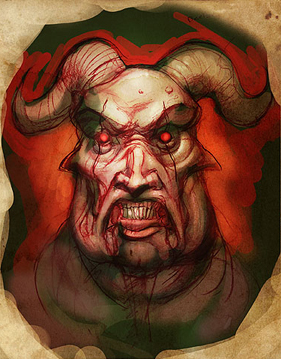
Beezlebub has appeared prominently in various satanic settings. In medieval times he was thought to preside over the witches' Sabbaths, and frequently copulated with witches in various orgies. In high society black masses during the 17th century he was one of the prime demonic deities being summoned. Summoning the Prince of Hell is a dangerous act that sorcerers perform at great risk, often suffering from death by epileptic seizure or by mysterious strangulation. Historically he has been cited as frequently possessing random individuals. He was identified as the demon responsible for a number of possessions in France in the 15th, 16th, and 17th centuries. He also possessed young Anna Ecklund in early 20th century Iowa, supposedly summoned there by the girl's father as a debased punishment for refusing to have incestuous sex with him. He was exorcised on December 23, 1928. One shudders to think when and where he might appear next...
October 20, 2015
Reliquary Tuesdays 5: Phylactery
Serving as a foul spirit's connection to this world, today's relic is less a famed type of artifact and more a magical device. It is known as...
A Phylactery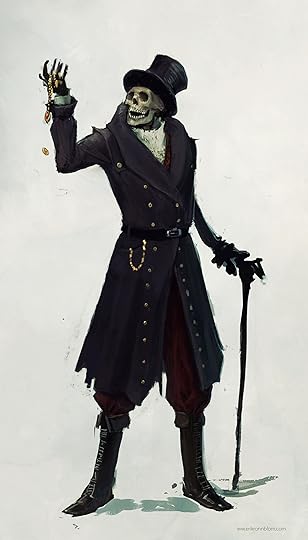
Phylacteries are objects used within the spell a lich uses to transform himself from a simple necromancer into an undead sorcerer. This ritual, sometimes called The Ritual of Ascendance, often takes a great deal of time, and the other reagents are presumably very exotic and hard to obtain. The Phylactery itself can be any item, and is typically selected by the necromancer prior to the ritual based on sentimentality. Once the Ritual of Ascendance has been completed the lich is inextricably bound to the selected item. If the phylactery is destroyed the lich's spirit loses its connection to this world, utterly destroying him.
This glaring Achilles heel leads liches to all manner of extreme lengths to protect their phylactery. Many place them inside massive, labyrinthine fortresses full of traps and undead guards. Others place them inside monstrous constructs they created and believe to be unstoppable. Others, the risk takers among them, leave them out in the open with the belief that no one will notice what's right under their nose. This last strategy is especially effective if their phylactery is a seemingly innocuous bauble, like an hourglass or even a writing utensil. No matter the case, all liches will protect their phylactery from danger with every ounce of their unnatural strength
October 18, 2015
Monster Mondays 5: The Mi-Go
From a cold planet residing in the solar system's shadowy edge exist a race of inhuman creatures, hyper intelligent fungal insects with a penchant for stealing brains. They are...
The Mi-Go

Originally appearing in H.P. Lovecraft's sonnet collection "The Fungi of Yuggoth" and later in his story "The Whisperer in the Darkness", the Mi-Go are a recurring race of alien creatures within the Cthulhu Mythos. In appearance they are a race of man-sized insects with multiple appendages and a pair of strange looking wings, in place of a head they have a mass of fleshy rings and growths lined in antennae. They are believed to communicate to each other through telepathy, but they are capable of physical speech, often described as like the buzzing of insects, and are capable of communicating in human languages. Many sources attribute some interdimensional properties to them, and most agree that the matter they are comprised of could not exist naturally on Earth. They are an ancient species, multiple references found within the work of Lovecraft and other authors stating that they had a war with Cthulhu's spawn and the Elder Things over ownership of prehistoric Earth. They come from a planet called Yuggoth, though this may not in fact be their original home. Their ability to travel across interstellar distances with only the use of their wings grants them incredible mobility, but it has been observed that they have difficulty traveling great distances on a terrestrial environment.

The Mi-Go are a highly mysterious race, rarely approaching humanity. Their goals are many and often times unclear to the linear thinking of men. While they typically try to avoid men they can be dangerous when provoked, and could quite possibly conquer the globe in its present state if they desired to. They remain in hiding, one supposed reason for this is they are hunted by a group of humans known as "The Brotherhood of the Yellow Sign". Given their name, this Brotherhood would be dedicated to the Great Old One Hastur, who was underdeveloped in Lovecraft's own fiction but given a more significant role by Mythos torchbearer August Derleth. In terms of their own religion, it is mentioned that they venerate Nyarlathotep and Shub-Niggurath, other eldritch beings in the Mythos. They are capable of transporting human beings to other worlds by surgically removing their brains and placing them in large, clear jars. They also posses the technology to attach certain apparatuses to these jars, allowing the brain to see, hear, even speak.
October 13, 2015
Reliquary Tuesdays 4: Monkey's Paw
A mysterious and dangerous object, found in hidden bazaars and esoteric shops in the Far East, this week's relic is known simply as...
The Monkey's Paw

Originally appearing in W. W. Jacobs' short story of the same name in 1902, the Monkey's Paw has become a iconic supernatural terror throughout the various genres of the English Canon. Its appearance is rather benign, seeming to be an ordinary severed monkey's paw that has been petrified and preserved. It has made countless appearances in books, television, cinema, animation, and comics.
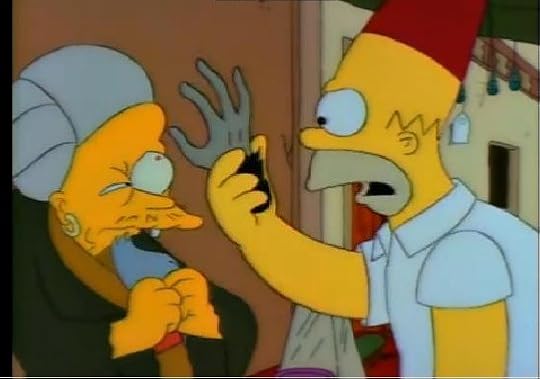
The powers of the Monkey's Paw may in fact be limitless, having demonstrated its capability to even raise the dead, giving it the ability to grant any wish its owner could possibly imagine. Every wish comes at a price however, and it usually ends up taking away everything its possessor holds dear. When the paw is passed on to a new owner its petrified fingers move to stand rigid, and as each wish is made a single finger folds back down. When the wishes are expended the paw forms a fist, and must be passed on to a new master before its powers can reset. Depending on the version of the story being told, the thumb may also represent a wish.
October 12, 2015
Monster Mondays 4: Perchten
From the icy mountains of Bavaria comes a strange, pagan creature known simply as...
The Perchten
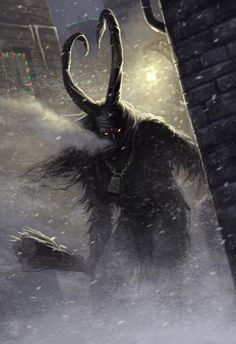
Demonic in appearance, the Perchten is actually a noble spirit originating in the folklore of Austria, Bavaria, and the regions of Northern Germany. They are the aids of Perchta, a pagan goddess of light and creativity. They are fanged and horned creatures with horse tails that they have perpetually sweeping behind them. This is done so that when they enter people's homes they can drive away any bad spirits that may have wandered in. Men in the 16th century would often wear masks depicting the Perchten, in order to honor Perchta and to participate in spiritual cleansing festivals.
October 6, 2015
Reliquary Tuesdays 3: Shrunken Heads
Found within the Northwest regions of the Amazon Rain Forest are superstitious tribes, holders of ancient traditions necessary for the preparation of...
Shrunken Heads
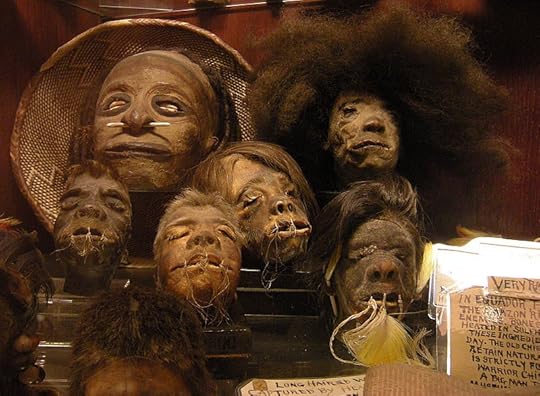
Shrunken heads are famous the world over, becoming a physical embodiment of the exotic and mystical secrets of the native South American peoples. The only tribes within South America known to shrink heads are those belonging to the Jivaroan lineage, including the Shuar, Achuar, Huambisa, and Aguaruna tribes. The process of shrinking a head is an arduous one, resigning the practice to use only after an important victory of the tribe. Enemy warriors would often be selected by the headshrinkers, as it was believed that the process of headshrinking left the spirit of the victim under the command of its killer. It is also believed that this prevented the spirit from coming back for revenge. The first step to shrinking a head is removing the skull and head. A small incision is made at the back of the neck and the skull is then removed, leaving behind the flesh and skin. Red seeds are inserted into the eyelids and then sewn shut. The mouth is typically held shut through the use of palm pins. A carved wooden ball is then inserted into the boneless flesh, allowing it to maintain its shape. It is then dried using hot rocks and sand with occasional molding to enable it to help keep the facial features from distorting too much. When the process is complete the head is then rubbed down with ash.
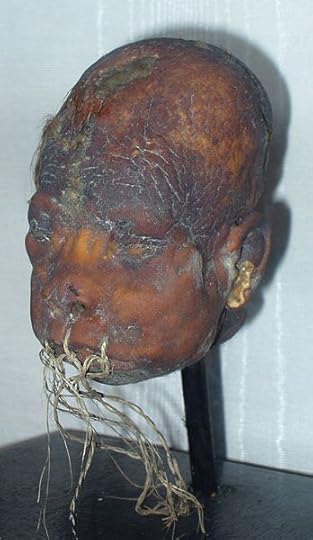
Shrunken heads were made with the intention of bending the spirits of the dead to the living's will. There are believed to be three main types of spirits within the Shuar portion of the Jivaroan peoples belief system. There is the Wakani, which resides within humans and survives after their deaths. Then there is Arutam, a powerful outside force which is believed to exist outside humanity, protecting them from violent deaths. Whenever someone is killed in battle or through some other form of violence, it is believed that the Arutam has been murdered with that person. The Arutam's murder summons the Muisak, a vengeful spirit which pursues the spirit's killer. As stated above, the process of shrinking heads is known to repel the spirit of Muisak, while the Wakani spirit is bent to the will of the headshrinker. Ash, typically applied to the skin of the head after it has been shrunk, is said to be the cause of the Muisak's repulsion. Colonial powers, such as Great Britain and Spain, created an economic demand for the heads by selling them abroad. In exchange for the heads the tribesmen were given guns and other commodities, which motivated them to increase the amount of heads they collected. This caused a spike in tribal warfare, leading to the deaths of thousands.



